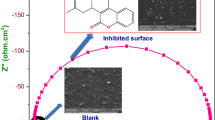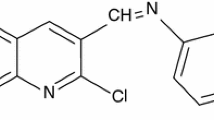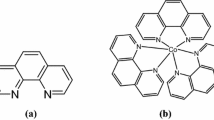Abstract
2-[(E)-{(1S,2R)-1-hydroxy-1-phenylpropan-2-ylimino}methyl]phenol has been synthesized and its influence on corrosion of mild steel in 1 M HCl solution has been studied by means of weight loss and electrochemical measurements under various circumstances. The inhibitor showed a maximum of 91 % of inhibition efficiency at 100 ppm. Interestingly, the inhibition efficiency has decreased on increasing the inhibitor concentration. This abnormal behavior is attributed to the release of phenolic hydrogen from the molecule. The mechanism of corrosion inhibition follows Langmuir adsorption isotherm. The negative ∆G ads indicates the spontaneous adsorption of the inhibitor on mild steel surface. Potentiodynamic polarization studies show that it is a mixed type inhibitor with predominant cathodic inhibition. UV–Visible spectroscopy of the inhibitor and inhibitor adsorbed on the mild steel confirmed the chemical interaction of the inhibitor with the metal surface.




Similar content being viewed by others
References
Sastri VS (1998) Corrosion inhibitors principle and application. Wiley, New York
Negm NA, Zaki MF (2009) Synthesis and evaluation of 4-diethyl amino benzaldehyde Schiff base cationic amphiphiles as corrosion inhibitors for carbon steel in different acidic media. J Surf Deterg 12:321–329
Raman A, Labine P, Quraishi MA (eds) (2004) Reviews on corrosion inhibitor science and technology, NACE Intl., Houston, vol 3
Negm NA, El-Farragry AF, Abdelrahman NR (2011) New Schiff base cationic surfactants: surface and thermodynamic properties and applicability in bacterial growth and metal corrosion prevention. J Surf Deterg 14:505–514
Ashassi-Sorkhabi H, Shaabani B, Seifzadeh D (2005) Corrosion inhibition of mild steel by some schiff base compounds in hydrochloric acid. Appl Surf Sci 239:154–164
Shokry H, Yuasa M, Sekine I, Issa RM, El-baradie HY, Gomma GK (1998) Corrosion inhibition of mild steel by Schiff base compounds in various aqueous solutions: part 1. Corros Sci 40:2173–2180
Emregül KC, Atakol O (2003) Corrosion inhibition of mild steel with Schiff base compounds in 1 M HCl. Mater Chem Phys 82:188–193
Negm NA, Zaki MF (2008) Corrosion inhibition efficiency of nonionic Schiff base amphiphiles of p-aminobenzoic acid for aluminum in 4 N HCl. Colloids Surf A 322:97–102
Aiad IA, Negm NA (2009) Some Schiff base surfactants as steel-corrosion inhibitors. J Surf Deterg 12:313–319
Negm NA, Aiad IA (2007) Synthesis and characterization of multifunctional surfactants in oil-field protection applications. J Surf Deterg 10:87–92
Negm NA, Mohammed AS (2004) Surface and thermodynamic properties of diquaternary bola-form amphiphiles containing an aromatic spacer. J Surf Deterg 7:23–30
Quraishi MA, Khan MAW, Ajmal M, Muralidharan S, Iyer SV (1997) Influence of heterocyclic anils on corrosion inhibition and hydrogen permeation through mild steel in acid chloride environments. Corrosion 53:475–481
Yulin W (1987) Composition and method for corrosion inhibition. US Patent 4664193
Muthu Tamizh M, Kesavan D, Sivakumar PM, Mereiter K, Deepa M, Kirchner K, Doble M, Karvembu R (2012) Antibacterial activities of 4-substituted-2-(E)-{(1S,2R)/(1R,2S)-1-hydroxy-1-phenylpropan-2-ylimino}methyl]phenol. Chem Biol Drug Des 79:177–185
Kesavan D, Muthu Tamizh M, Gopiraman M, Sulochana N, Karvembu R (2012) Physicochemical studies of 4-substituted N-(2-mercaptophenyl)-salicylideneimines: corrosion inhibition of mild steel in an acid medium. J Surf Deterg. doi:10.1007/s11743-012-1338-z on line first, March 9, 2012
Galvery, WL, Marlow, FM (2001) Welding essentials: questions and answers, 1st edn. Industrial Press Inc., New York, p 283
ASTM-G31-72, (2004) Standard practice for laboratory immersion corrosion testing of metals. Annual book of ASTM Standards, Philadelphia
Frank W, Jens F, Jens N, Horst-Artur C, Volker K, Alexander P, Felix B, Henning W (2006) In vitro and in vivo corrosion measurements of magnesium alloys. Biomaterials 27:1013–1018
Quartarone G, Bonaldo L, Tortato C (2006) Inhibitive action of indole-5-carboxylic acid towards corrosion of mild steel in deaerated 0.5 M sulfuric acid solutions. Appl Surf Sci 252:8251–8257
Riggs OL (1973) Corrosion inhibitors, 2nd edn. Nathan, C. C., Houston, p 43
Mohammad M, Ali RTB, Krister H (2011) Comparison of a cationic gemini surfactant and the corresponding monomeric surfactant for corrosion protection of mild steel in hydrochloric acid. J Surf Deterg 14:605–613
Hosseini M, Metrtens FL, Ghorbani M, Arshadi RM (2003) Asymmetrical Schiff bases as inhibitors of mild steel corrosion in sulphuric acid media. Mater Chem Phys 78:800–808
Quraishi MA, Jamal D (2000) Dianils: new and effective corrosion inhibitors for oil-well steel (N-80) and mild steel in boiling hydrochloric acid. Corros Sci 56:156–161
Manuel EP, Crescencio OO-X, Natalya VL, Jonathan-Boanerge P-N (2011) Imidazolium, pyridinium and dimethyl-ethylbenzyl ammonium derived compounds as mixed corrosion inhibitors in acidic medium. J Surf Deterg 14:211–220
Zaafarany I, Abdallah A (2010) Ethoxylated fatty amide as corrosion inhibitors for carbon steel in hydrochloric acid solution. Int J Electrochem Sci 5:18–28
Gopiraman M, Selvakumaran N, Kesavan D, Karvembu R (2012) Adsorption and corrosion inhibition behaviour of N-(phenylcarbamothioyl)benzamide on mild steel in acidic medium. Prog Org Coat 73:104–111
Gopiraman M, Sathya C, Vivekananthan S, Kesavan D, Sulochana N (2012) Influence of 2,3-dihydroxyflavanone on corrosion inhibition of mild steel in acidic medium. J Mater Eng Per 16:240–246
Noor EA (2007) Temperature effects on the corrosion inhibition of mild steel in acidic solutions by aqueous extract of Fenugreek leaves. Int J Electrochem Sci 2:996–1017
Author information
Authors and Affiliations
Corresponding author
About this article
Cite this article
Kesavan, D., Muthu Tamizh, M., Sulochana, N. et al. 2-[(E)-{(1S,2R)-1-Hydroxy-1-phenylpropan-2-ylimino}methyl]phenol for Inhibition of Acid Corrosion of Mild Steel. J Surfact Deterg 15, 751–756 (2012). https://doi.org/10.1007/s11743-012-1370-z
Received:
Accepted:
Published:
Issue Date:
DOI: https://doi.org/10.1007/s11743-012-1370-z




